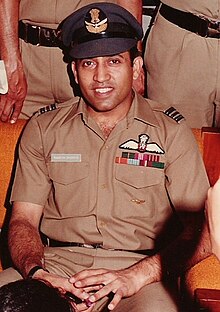|
Rakesh Sharma
Wing Commander Rakesh Sharma, AC (born 13 January 1949) is an Indian astronaut and a former Indian Air Force officer. He flew aboard Soyuz T-11 on 3 April 1984 as part of the Soviet Interkosmos programme. He is the only Indian citizen to travel in space, although there have been other astronauts of Indian origin who travelled to space, who were not Indian citizens.[1][2] Another Air Force pilot, Ravish Malhotra, was placed on standby.[3] Early lifeBorn on 13 January 1949 in Patiala of present-day Punjab, India into a Punjabi family.[4] Sharma attended St. George's Grammar School, Hyderabad[4] and graduated from Nizam College, Hyderabad. He joined the National Defence Academy as an air force plebe in July 1966[5] and was commissioned into the Indian Air Force as a pilot in 1970.[6] He flew 21 combat missions as a MiG-21 pilot during the 1971 Bangladesh Liberation War.[7] CareerIAF careerAn alumnus of the 35th National Defence Academy, Sharma joined the Indian Air Force as a test pilot in 1970 and progressed through numerous levels where in 1984 he was promoted to the rank of squadron leader.[4] He was selected on 20 September 1982 to become a cosmonaut and go into space as part of a joint programme between the Indian Air Force and the Soviet Interkosmos space programme.[8] Cosmonaut In 1984, Sharma became the first Indian citizen to enter space when he flew aboard the Soviet rocket Soyuz T-11 launched from Baikonur Cosmodrome in the Kazakh Soviet Socialist Republic on 3 April 1984. The Soyuz T-11 spacecraft carrying cosmonauts including Sharma docked and transferred the three member Soviet-Indian international crew, consisting of the ship's commander, Yury Malyshev, and flight engineer, Gennadi Strekalov, to the Salyut 7 Orbital Station. Sharma spent 7 days, 21 hours, and 40 minutes aboard the Salyut 7 during which his team conducted scientific and technical studies which included forty-three experimental sessions. His work was mainly in the fields of bio-medicine and remote sensing.[8] The crew held a joint television news conference with officials in Moscow and then Indian Prime Minister Indira Gandhi. When Indira Gandhi asked Sharma how India looked from outer space, he replied, "Sare Jahan Se Accha" (better than the whole world). This is the title of a patriotic poem by Iqbal that had been written when India was under British colonial rule, that continues to be popular today. With Sharma's voyage aboard Soyuz T-11, India became the 14th nation to send a man to outer space.[8] Post-retirementSharma retired as a wing commander and later joined Hindustan Aeronautics Limited (HAL) in 1987, serving as the chief test pilot in the HAL Nashik Division until 1992, before moving on to Bangalore to work as HAL's chief test pilot. Sharma retired from flying in 2001.[1] Military awards and decorationsSharma was conferred the honour of the Hero of the Soviet Union upon his return from space. He remains to date the only Indian to have been conferred this honour. India also conferred its highest peacetime gallantry award, the 'Ashoka Chakra', on him and the two Soviet members of his mission, Malyshev and Strekalov.[8] The citation for the Ashoka Chakra reads as follows:[9]
Ribbon bar
Personal lifeSharma married Madhu. His son, Kapil, is a film director,[10] while his daughter, Krittika, is a media artist.[citation needed] Popular cultureA biographical Hindi-language film titled, Saare Jahaan Se Achcha (formerly "Salute"), is under pre-production since 2018.[11] See alsoReferences
External linksWikimedia Commons has media related to Rakesh Sharma. Wikiquote has quotations related to Rakesh Sharma.
|
||||||||||||||||||||||||||||||||||||||||||||||||||||||||||||||

